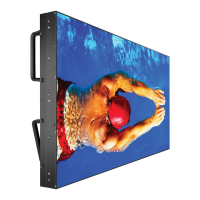
Do you have a question about the NEC MultiSync X401S and is the answer not in the manual?
| Screen Size | 40" |
|---|---|
| Resolution | 1920 x 1080 |
| Brightness | 500 cd/m² |
| Contrast Ratio | 4000:1 |
| Response Time | 8 ms |
| Viewing Angle | 178°/178° |
| Aspect Ratio | 16:9 |
| Power Consumption | 150 W |
| Native Resolution | 1920 x 1080 |
| Connectivity | HDMI, DisplayPort, DVI-D, VGA |
| Input Connectors | HDMI, DVI-D, VGA, DisplayPort |
Critical warnings about fire and electric shock hazards, and cabinet safety.
Precautions to reduce electric shock and warnings about internal components.
Guidelines for safe operation, handling, and placement of the monitor.
Guidance on ensuring the mounting location is strong enough to support the unit.
Key considerations for mounting the monitor on walls or ceilings.
Guidelines for selecting a safe and suitable mounting location.
Specific instructions and safety measures for ceiling mounting.
Ensuring adequate airflow for heat dissipation in enclosed spaces.
Methods to prevent the monitor from tipping over when using the stand.
Detailed description of each button on the monitor's control panel and their functions.
Diagram and description of input/output terminals for the X401S model.
Diagram and description of input/output terminals for the X462S/X552S models.
Detailed explanation of each numbered terminal and its function.
Detailed description of each button on the wireless remote control and their functions.
Guidance on selecting an appropriate and safe location for the monitor.
Instructions for connecting various external devices to the monitor.
Procedure for safely connecting the monitor to a power outlet.
Visual representation of various video and audio signal connections.
Table detailing connected equipment, terminals, settings, and remote inputs.
Guidelines for connecting a PC, including resolution and timing compatibility.
Instructions for connecting devices via HDMI, including cable recommendations.
Instructions for connecting devices via DisplayPort, including cable requirements and limitations.
How to power the monitor on and off using the power button and main switch.
Procedure for choosing the desired input signal for display.
How to navigate and use the OSD menus with the remote control and panel buttons.
Explanation of button functions for OSD menu interaction.
Detailed explanation of PICTURE menu settings like Backlight, Contrast, Sharpness, etc.
Settings for Auto Setup, Position, Clock, Phase, Resolution, and Aspect.
Controls for Volume, Balance, Treble, Bass, Surround, and audio inputs.
Settings for Off Timer, Schedule Settings, Date & Time, and Year/Month/Day configuration.
Options for Picture-in-Picture modes, size, position, and aspect.
Settings for Information OSD, Transparency, Rotation, Input Name, and Reset.
Configuration for Control ID, IR Control, and TILE MATRIX features.
Settings for RS-232C/LAN control, LAN settings, and Power On Delay.
Features like Power Save, Heat Status, Screen Saver, and Security Password.
Steps to resolve issues with no picture, power, image persistence, or display problems.











